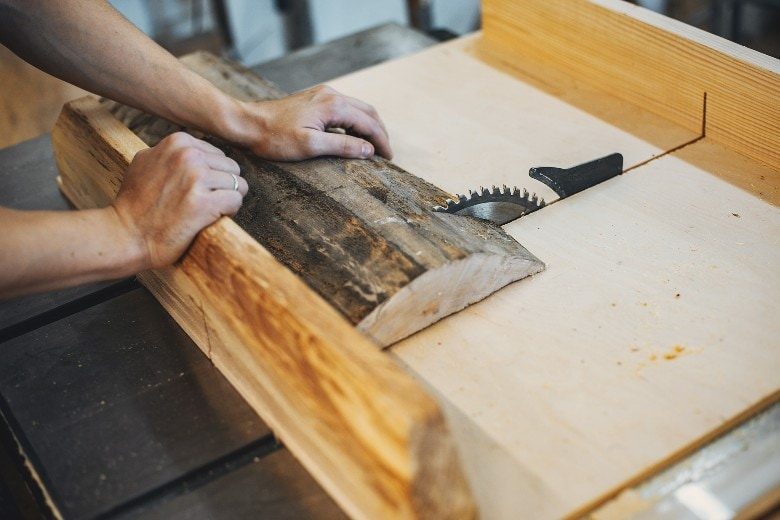Woodworking often involves making jigs that increase the accuracy, safety, and speed of using power tools. A table saw sled is one of those essential jigs for a woodworking workshop. The jig is simple to make and provides several benefits to your woodworking experience.
I have used a table saw sled for a while now, and it has helped improve my crosscuts on the table saw. Building a table saw sled is a fun project that I would suggest to any woodworker, no matter their skill level.
Why Use A Table Saw Sled?
- Increases safety while cutting
- Prevents shifting while feeding
- Improves crosscut accuracy
- Allows you to work faster
- Makes repetitive cuts easy
- Produces more accurate miter cuts
- Simple and cheap to make
Increases safety while cutting
Most table saws come with a miter gauge. It keeps your workpiece aligned while you cut, but it also provides the support needed to crosscut wood safely.
A table saw sled provides extra support with a longer backstop that is also taller. The sled supports the workpiece and the excess material after passing the blade, helping prevent debris from being kicked back toward you. It also supports larger pieces better than a miter gauge can.
A table saw sled keeps your fingers away from the saw blade. That is important when you are crosscutting smaller pieces of stock. Finally, a table saw sled reduces slipping from finger pressure or resistance from the tabletop.
Prevents shifting while feeding
One of the benefits that woodworkers appreciate from using a table saw sled is the reduction in slipping I just discussed. You have to press down towards the table and against the fence of a miter gauge to keep the workpiece from sliding as you move. A sled, however, supports the wood from the bottom, which reduces the finger pressure you need to maintain.
Less finger pressure will result in fewer movements, including on smooth surfaces you are cutting. The sled’s bottom support also eliminates friction between the workpiece and the tabletop. Alignment is maintained throughout the cut due to the sled riding in the miter gauge slots.
Improves crosscut accuracy
For most woodworkers, this is the benefit that encourages them to make a table saw sled. The rigid support and alignment provided by the sled keep your wood positioned for a precise crosscut.
Again, your wood sits on the bottom of the sled and not the tabletop of your saw. Friction will not pull it one way or the other as you slide it through the cut.
The larger backstop of the sled provides more support for the workpiece to press against while crosscutting. That prevents the wood from rocking at the start of the cut, especially on smaller pieces.
The bottom support and larger backstop are appreciated when working with wood that is hard to control due to length, weight, or width.
Allows you to work faster
Quick alignment is one trick that experienced woodworkers use when operating their table saw sled. You can use the groove cut into the bottom of the sled to line up your cutline instead of the saw blade.
Making several of the same cuts is faster when using a table saw sled equipped with a stop. You can also secure the workpiece onto a sled faster with accessories like a clamp.
You can crosscut small components without having to create elaborate jigs on the spot to hold them. Boards that are long, heavy, or wide can be fed faster on a sled than using a miter gauge alone.
Makes repetitive cuts easy
Using a table saw sled allows you to make several of the same cuts quickly. You can purchase an aftermarket stop that acts as a block that the end of your workpiece touches. You can also make a stop out of scrap wood and a clamp.
The stop sits so that each pass across the saw blade cuts pieces to the desired length. You butt the wood against the stop block and cut. The process repeats until you have the desired number of identical boards.
Produces more accurate miter cuts
A table saw sled can cut boards at an angle. You can create a backstop that sits at a predetermined angle. The lumber rests on the backstop, and the miter cuts as you move the sled across the saw blade.
A protractor-style backstop that adjusts can also produce accurate miter cuts. The sled provides a larger surface for marking degrees of an angle, allowing you to set finite angles smaller than a degree.
Its bottom and backstop support prevent the wood from slipping as the saw blade cuts into the fibers at an angle. The result is cleaner and at the correct angle across the entire end of the board. Once you set the mitered angle on the table saw sled, you can make several repeat cuts quickly.
Simple and cheap to make
A table saw sled is easy to make. Its major components are the runners for the miter gauge track, the sled bottom, and the backstop. You can upgrade your design to include a front stop, angled supports, or an adjustable mitered backstop.
Prefabricated table saw accessories can be quite expensive. Another feature of the table saw sled is that you can make it from wood in your shop. Framing lumber and plywood are the most popular materials and are purchased cheaply at most big-box stores.
Glue and a handful of fasteners are the only extras beyond the wood. You can buy accessories like clamps, rulers, or stops to customize your table saw sled to fit your shop’s needs.
Sledding All-Year-Long
A table saw sled improves your woodworking and increases the safe usage of your table saw. It can increase your enjoyment of the hobby, making it an accessory that you will use whenever you have to crosscut on the table saw.

